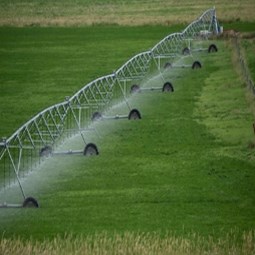
Resources and Environment
(Selected research findings from Fiscal Year 2020. Much of this research pre-dates the pandemic. Please visit www.ers.usda.gov/covid-19/ for the latest ERS research related to COVID-19)
Increasing demands for limited water resources and concerns for agricultural drought resilience under heightened water scarcity has prompted renewed interest in irrigation organizations. Working with partners both inside and beyond USDA, ERS developed a 2019 national Survey of Irrigation Organizations to provide the first updated dataset of local water-supply management entities since the 1978 Census of Irrigation Organizations. In 2019, there were 2,677 organizations directly involved in the management of local water supplies—both groundwater and surface water—for irrigation on farms and ranches. This initiative builds upon ERS research collaborations that address regional groundwater management—including managed aquifer recharge in California’s Central Valley and the Lower Mississippi River alluvial aquifer, and groundwater sustainability in the High Plains. Survey findings will inform future research efforts as well as an array of Federal and State program activities.
Most expiring land in the Conservation Reserve Program returned to crop production.
The Conservation Reserve Program (CRP) is the largest land retirement program in the United States. Under CRP, landowners voluntarily retire environmentally sensitive cropland for 10 to 15 years in exchange for an annual rental payment. Once a CRP contract expires, land may be offered for reenrollment, which is dependent on the availability of CRP signup opportunities. An ERS report examines the fate of land that exited the CRP between 2013 and 2016. Results show, overall, about 36 percent of expiring CRP land was reenrolled in the program. And about 81 percent was put into some type of crop production, with the remainder going into grass, tree, and other non-agricultural covers.
 Resource Requirements of Food Demand in the United States
Resource Requirements of Food Demand in the United States
Natural resources—land, water, minerals, air, and forests—provide materials and services necessary to produce and market the food we eat. To supply the food production to meet the food demand of a growing population, it is important to understand the U.S. food system’s impact on these natural resources. An ERS report examined the role of diet choices in the food system’s use of natural resources. Results showed that if in 2007, the diets of people living in the U.S. met all the 2010 USDA Dietary Guidelines for Americans , then per capita consumption of the fruits, vegetables, legumes/nuts/seeds, eggs, and dairy categories would have increased. However per capita consumption in the sugars/sweets/beverages, fats/oils/salad dressings, grain products, and meat/poultry/fish/mixtures food groups would have declined. In such a scenario, use of productive agricultural land, fossil fuels, and forest products would have decreased, while freshwater withdrawals would have increased. Greenhouse gas emissions (GHG) would have remained essentially unchanged with a conversion to the Healthy American diet. Reductions in GHG emissions linked to reduced fossil fuel use would have been offset by increases linked to biogenic emissions.


